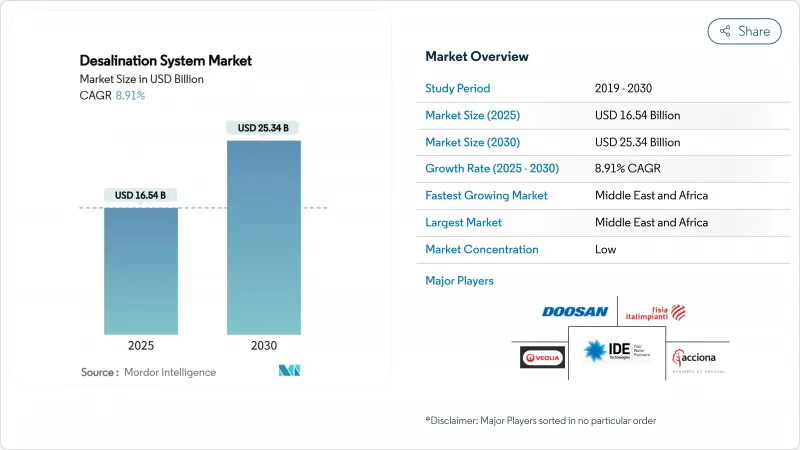
|
市場調査レポート
商品コード
1851992
海水淡水化システム:市場シェア分析、産業動向、統計、成長予測(2025年~2030年)Desalination System - Market Share Analysis, Industry Trends & Statistics, Growth Forecasts (2025 - 2030) |
||||||
カスタマイズ可能
適宜更新あり
|
|||||||
| 海水淡水化システム:市場シェア分析、産業動向、統計、成長予測(2025年~2030年) |
|
出版日: 2025年08月11日
発行: Mordor Intelligence
ページ情報: 英文 120 Pages
納期: 2~3営業日
|
概要
海水淡水化システム市場規模は2025年に165億4,000万米ドルと推定・予測され、予測期間中(2025~2030年)のCAGRは8.91%で、2030年には253億4,000万米ドルに達すると予測されます。

持続的な水不足、沿岸部の急速な都市化、政府支援の官民パートナーシップ(PPP)が需要を支えている一方、逆浸透膜(RO)のエネルギー強度は3kWh m3を下回り、対応可能な機会が広がっています。統合型エネルギー回収装置は現在、ブライン流圧の最大60%を回収し、海水淡水化システム市場を0.50m3以下の生産ベンチマークへと押し上げています。中東・北アフリカ(MENA)のプロジェクトスポンサーは、数十億米ドル規模のプラントのリスクを軽減する長期引取契約を展開し、アジア太平洋の半導体メーカーは産業用再利用の義務付けを加速させています。
世界の海水淡水化システム市場動向と洞察
中東・北アフリカ(MENA)における都市用水需要の急増
都市部の水不足は、中東・北アフリカ全域で海水淡水化を補助的インフラから基幹供給へと再位置付けしています。モロッコは国家水計画の下、2030年までに年間14億m3-1を目標に掲げており、アルジェリアは新規設備に30億米ドルの予算を計上し、エジプトは世界最大のROステーションを稼働させました。自治体との引取保証契約はキャッシュフローを安定させ、事業者は単価を0.50m3米ドル以下に抑える大容量トレインを導入することができます。湾岸の巨大都市周辺では都市化が進み、継続的な取水が可能になるため、海水淡水化システム市場がさらに活性化します。
産業用再利用の義務化(半導体、製薬会社)
チップ製造は現在、水不足に悩むAPACのハブに移行しており、そこではクローズドループの再利用によって淡水の取水量を95%削減することができます。半導体および製薬クラスターでは、ゼロ液体排出(ZLD)指令により、超高回収膜に対する価格非弾力的な需要が生じています。施設は、導電率0.1µS cm-1目標を達成するために、第2段階のROと電気透析反転研磨を統合し、海水淡水化システム市場の産業用収益構成を引き上げています。規制の確実性がプレミアム価格を可能にし、景気後退からサプライヤーを守る。
RO膜のファウリングとスケーリング
バイオや有機物の汚れは、数カ月以内にフラックスを30%削減する可能性があり、OPEXに0.10~0.15米ドルを追加する頻繁な化学洗浄を余儀なくされます。CaCO3やCaSO4によるスケーリングは、供給圧力を上昇させ、エネルギー消費量を急増させる。酸化グラフェン層は親水性を高めるが、コストと寿命が未知数であるため、商業的な展開はまだ始まったばかりです。オペレーターは現在、膜の寿命を延ばすためにAI主導の前処理制御を導入しているが、ファウリングは依然として塩分濃度の厳しい地域での海水淡水化システム市場の成長を抑制しています。
セグメント分析
膜プロセスは、2024年の海水淡水化システム市場シェアの78.92%を占め、ROエネルギーが3 kWh m3を下回るにつれて、このスライスはCAGR 10.70%で拡大しています。ROは依然として主力であるが、電気透析による逆浸透が塩分濃度3g L-1以下の汽水域のニッチを開拓しつつあり、そこでは1.5kWh m3のフットプリントが優れています。
超マイナス電荷密度を持つナノろ過の進歩は、現在、医薬品のZLDライン向けに内分泌撹乱物質を捕捉しています。熱法は湾岸のコジェネレーション施設に根強く残っているが、統合型太陽光発電とエネルギー回収が平準化コストの差を縮めるにつれて、そのシェアは後退し、海水淡水化システム市場における膜の優位性を強めています。
海水淡水化システムレポートは、分離技術(熱技術、膜技術)、用途(自治体、産業)、地域(アジア太平洋、北米、欧州、南米、中東・アフリカ)で区分されています。市場予測は金額(米ドル)で提供されます。
地域別分析
中東・アフリカは2024年に海水淡水化システム市場シェアの52.70%を占め、2030年までCAGR 10.62%で成長します。サウジアラビアとUAEのギガワットPV-ROハイブリッドは、統合された自然エネルギーがいかに運転コストと炭素プロファイルを削減するかを例証しています。
北米は転換期を迎えている:テキサス州は、米国最大の海水RO施設である7億5,700万米ドルのコーパスクリスティプラントを承認し、カリフォルニア州は沿岸ROと直接飲用水再利用の許可を合理化しました。Energy Recovery社やDuPont社などのテクノロジー・ベンダーは、地域のリファレンス・プロジェクトを活用して、ダウンタイムを15%削減するAI主導の予知保全を実証し、海水淡水化システム市場をさらに拡大しています。
アジア太平洋と欧州は、その地位を固めつつあります。シンガポールのケッペル・マリーナ・イーストは、公共の憩いの場と地下のROパイプを融合させ、美的統合を披露しています。干ばつ対策として海水淡水化に依存しているスペインでは、従来の多段フラッシュユニットを高圧ROでアップグレードし、40%の省エネを達成。
その他の特典:
- エクセル形式の市場予測(ME)シート
- 3ヶ月間のアナリストサポート
よくあるご質問
目次
第1章 イントロダクション
- 調査の前提条件と市場の定義
- 調査範囲
第2章 調査手法
第3章 エグゼクティブサマリー
第4章 市場情勢
- 市場概要
- 市場促進要因
- 中東・北アフリカにおける都市用水需要の急増
- 産業用再利用義務(半導体、製薬)
- RO CAPEXとエネルギー回収コストの低下
- グリーン水素クラスター需要(沿岸砂漠地帯)
- PPPを引き受けるソブリン水安全保障ファンド
- 市場抑制要因
- RO膜のファウリングとスケーリング
- ブライン排出の環境影響
- エネルギー価格に対する高プロジェクトCAPEX感応度
- バリューチェーン分析
- ポーターのファイブフォース
- 供給企業の交渉力
- 買い手の交渉力
- 新規参入業者の脅威
- 代替品の脅威
- 競争企業間の敵対関係
第5章 市場規模と成長予測
- 分離技術別
- 熱技術
- 多段フラッシュ蒸留(MSF)
- 多重効用蒸留(MED)
- 蒸気圧縮蒸留
- メンブレン技術
- 電気透析(ED)
- 電気透析リバーサル(EDR)
- 逆浸透膜(RO)
- その他の膜技術(ナノろ過、限外ろ過、精密ろ過)
- 熱技術
- 用途別
- 市町村
- 産業
- 地域別
- アジア太平洋地域
- 中国
- インド
- 日本
- その他アジア太平洋地域
- 北米
- 米国
- メキシコ
- 南米
- ブラジル
- チリ
- その他南米
- 欧州
- ドイツ
- 英国
- スペイン
- その他欧州地域
- 中東・アフリカ
- サウジアラビア
- アラブ首長国連邦
- アルジェリア
- エジプト
- その他の中東・アフリカ
- アジア太平洋地域
第6章 競合情勢
- 市場集中度
- 戦略的動向
- 市場シェア(%)**/ランキング分析
- 企業プロファイル
- Acciona
- Aquatech
- Biwater Holdings Limited
- Doosan Enerbility
- DuPont
- Energy Recovery Inc.
- Fisia Italimpianti
- Fluence Corporation Limited
- IDE
- Kanadevia Corporation
- Metito Utilities
- Ocean Oasis
- Toray Industries Inc
- Veolia
- Wabag
- Xylem

